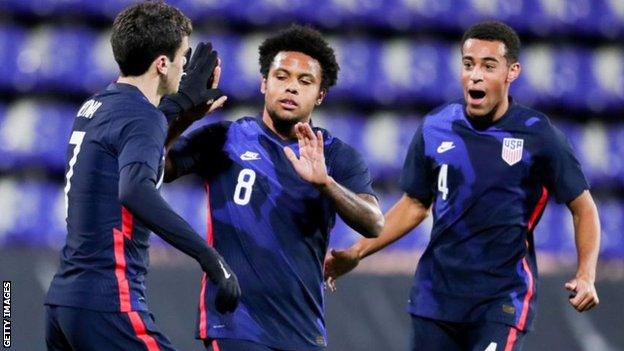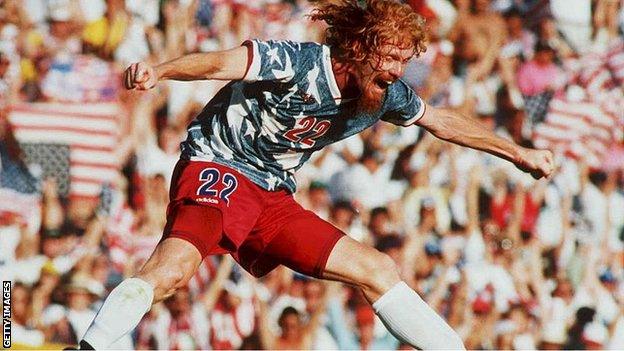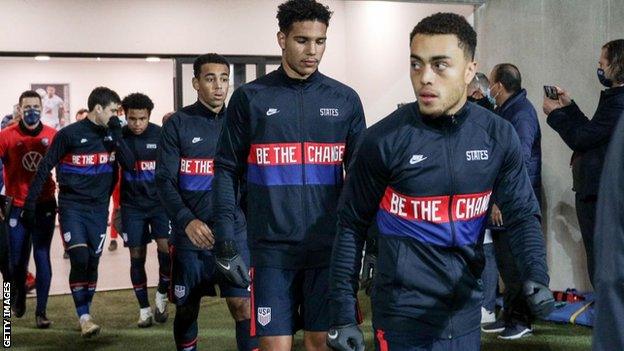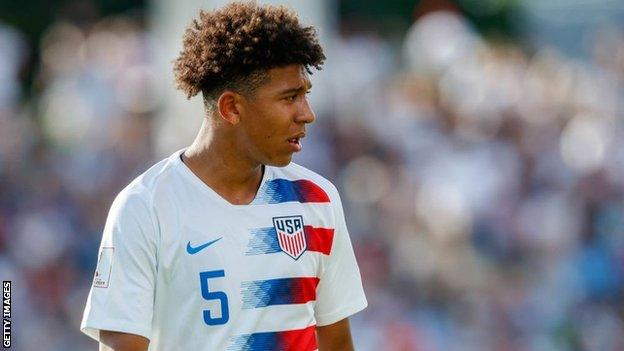World Cup 2026: Are USA building towards success on home soil in 2026?
- Published


Giovanni Reyna, Weston McKennie and Tyler Adams have all played in the Champions League this season
When 14-year-old Freddy Adu became the youngest player to sign a professional contract in the 2004 Major League Soccer draft, it was expected to herald a new dawn for men's football in the United States.
At a similar time, authorities in the country were looking towards the success of their European counterparts in an attempt to revolutionise the way the nation developed its most talented young players.
Adu, the child prodigy supposedly destined for greatness, made only 17 appearances for his country during a journeyman career that most recently saw him leave third-tier Swedish side Osterlen last month having not played a single game.
In contrast, the ambitions harboured by US soccer chiefs are now coming to fruition, with more American players featuring in the Champions League this season than ever before.
Among them, Weston McKennie has impressed at Juventus, Sergino Dest excelled for Barcelona in the last 16 despite being knocked out by Paris St-Germain, Tyler Adams scored the goal that took RB Leipzig to the semi-finals last year and Chelsea's Christian Pulisic and Borussia Dortmund's Giovanni Reyna are both exciting talents.
In total, nine players featured in Europe's elite competition this term, all aged 25 or under, and their emergence looks particularly timely with the US set to host the 2026 World Cup alongside Canada and Mexico.
The aim, according to former US soccer president Carlos Cordeiro, is to "put football on a new and sustainable path for generations to come".
Average crowds of 68,626 watched each game when the US last hosted the men's World Cup in 1994, more than 3.5m people in total, making it the most-attended tournament of all time and whetting the appetite for the game in a country that had previously featured in just four of 14 tournaments.
In exchange for hosting the tournament, Fifa tasked organisers with launching a professional US competition and Major League Soccer duly kicked off in 1996. Its legacy? A generation of players produced by MLS clubs believing they can be successful this time they host the tournament.
"I get goosebumps just thinking about it," Leipzig midfielder Adams, who came through the New York Red Bulls academy, tells BBC Sport.
"We'll be experienced, we'll have a lot of games under our belt, international experience will hopefully be there and we're going to be ready to compete."
Chris Richards, on loan at Hoffenheim from Bayern Munich, adds: "To be able to win a World Cup on home soil, that's something we're kind of expecting to do at this point."

The hosts were knocked out in the second round by eventual champions Brazil in the 1994 World Cup

There is an exciting new breed of youngsters emerging from the US and top European clubs are taking notice.
The trickle of talent continued in the latest transfer window, with Roma signing 19-year-old full-back Bryan Reynolds from FC Dallas and the highly rated Brenden Aaronson joining Red Bull Salzburg from Philadelphia Union.
One European scout told BBC Sport the North American market has always been on clubs' radar, but the region is now producing "modern, athletic players who can cope with high-intensity demands" and who have the "correct drive and focus".
While World Cup 94 piqued interest, Larry Sunderland, director of player development at MLS side FC Cincinnati and coach of the US Under-16 and Under-17 teams, believes the turning point in producing talent came 14 years ago.
"Player development is all about patience," he tells BBC Sport. "We got serious about player development with the advent of US Soccer's Development Academy in 2007.
"We started to get the best of the best playing together. It defined our pathway, defined our pyramid, and more than ever it encouraged free-play scenarios, rather than pay-to-play. At the highest level, it really encouraged clubs to make an investment in players."
It provided a streamlined pipeline of talent for MLS clubs by getting the best youngsters to train and play together for 10 months of the year, exposing them to better coaching and a more professional environment. It put an emphasis on clubs to develop youth players.
"They invested heavily, by MLS standards, in player development, in facilities, in personnel," explains Sunderland.
This included educating coaches through a programme with the French Football Federation, whose own elite academy structure at Clairefontaine was established 10 years before their first World Cup triumph in 1998.
"The top development talent in the US was put through the French Federation coaching school - we were exposed to the French methodology," adds Sunderland. "With those things coming together and the idea of patience, you're seeing it all pay off now."
US men's head coach Gregg Berhalter agrees, telling radio station SiriusXM last year the programme has "been everything" for youth football in the country.
At national age-group level it has led to a stronger pool of players and Sunderland says US Soccer has expanded its scouting network to complement this, while also teaching scouts to identify specific players that fit their desired profile.
"MLS clubs are investing and US Soccer is investing more time and resources into talent identification," says Sunderland.
"US sports tend to identify physical athletes first - I think we're scratching the surface on what a footballer looks like, how a footballer moves and this is something different than an American Football player or a basketball player. We're getting better at that."
American players to feature in this season's Champions League | |
|---|---|
Weston McKennie (Juventus) | Giovanni Reyna (Borussia Dortmund) |
Sergino Dest & Konrad de la Fuente (Barcelona) | Christian Pulisic (Chelsea) |
Tyler Adams (RB Leipzig) | Chris Richards (Bayern Munich) |
Zack Steffen (Manchester City) | Ethan Horvath (Club Brugge) |

The standard of the MLS is improving but the feeling remains American players need to be in Europe to fulfil their potential.
Adams, who despite only turning 22 last month is one of the more experienced players in a youthful national set-up, highlights the success of midfielder McKennie playing alongside Cristiano Ronaldo at Juventus and Dest and Konrad de la Fuente training every day with Lionel Messi at Barcelona.
"It's just a confidence thing, trusting in our abilities - clubs are taking us in and they're developing us," says Adams. "We're learning new ideas, new philosophies and we're just going to get better."
Young Americans now have such a presence on the continent that when defender Richards made his international debut in November, 23 of the squad played for European clubs - and the same number have been called up for games against Jamaica and Northern Ireland this week.
"After the first day or so, once we started clicking, we realised if we keep playing together and keep doing what we are doing at our clubs and come back and bring it to the national team, we are going to be unstoppable in a few years," says Richards.
"It makes us trailblazers. It's showing kids back home that if they put their mind to it, they can also do it. We don't just have to confine ourselves to playing in the US or playing college soccer or MLS, we can do more than that."
The Bundesliga is a particular hotbed for American talent, with Adams, Richards and Dortmund's Reyna joined by the likes of Werder Bremen forward Josh Sargent and Schalke's 20-year-old striker Matthew Hoppe, who has burst onto the scene this season.
Richards' move to Bayern Munich was a result of a link with FC Dallas which also saw six players from the club given the opportunity to train with the European champions in January, while Adams arrived in Leipzig from their Red Bull counterparts in New York.
Last year, FC Cincinnati formed a partnership with Hoffenheim with the aim of sharing "knowledge, talent, business and brand social responsibility".
But it is not just German clubs who have a foothold in North America. Atletico Madrid recently formed Atletico Ottawa in Canada, Manchester City and New York City are both part of the City Football Group, while Rangers have a strategic partnership with US second-tier side Orange County.
That link will see the Scottish giants sign Francis Jacobs when he turns 16 later this year, a midfield prospect who surpassed Adu as the youngest professional in the history of US soccer when he signed with the USL Championship outfit aged 14 years, four months and 29 days.

Full-back Sergino Dest joined Barcelona from Ajax last year
In some leagues, American influence can be seen more in boardrooms and 'Moneyball'-style recruitment systems, with a recent surge in investment in Italy's Serie A as AC Milan, Fiorentina, Roma, Parma and Spezia were all acquired by US owners.
One scout working in Italian football says American owners want to develop clubs and stadiums in cities where they can "sell" the product abroad, while their involvement has also seen scouting and recruitment methods seep in from North American sports.
But why are American clubs willing to let their best players leave for Europe?
The last time the US hosted a World Cup, MLS didn't exist. The acquisition and development of talent is therefore a relatively new phenomenon for most of its franchises and until recently clubs were losing their best youngsters for free.
"We're learning now that we can sign our players young and encourage them to go to Europe, but we're getting money on the back end," explains Sunderland.
"That's as opposed to not signing a player, waiting until we think the player is really ready, and in the meantime a European club coming over and grabbing him."
Sunderland says it has taken a shift in mindset, mainly from players' parents, to accept a move away from the traditional American sports model of playing at school, going to college and then entering the professional draft.
Now most are more open to their sons signing a professional deal at a younger age and continuing their education on the side.
But allowing players to leave for Europe is not solely about clubs being reimbursed for their talent. MLS franchises have growing financial clout, as shown by FC Cincinnati signing Brazilian forward Brenner from Sao Paulo for almost £10m in February.
"We're learning the business of football better," adds Sunderland. "We're moving players around the world leagues with greater success and that's only going to benefit the national team and is only going to benefit MLS."

Chris Richards was part of the USA side that reached the quarter-finals at the Under-20 World Cup in 2019

One battle the game has faced is competing with the country's traditional sports to win the hearts of youngsters, pushing MLS clubs to bring players into their academies at a young age.
Adams, also a talented basketball player, was 11 when he joined the New York Red Bulls academy but believes the sport's popularity has rocketed in the past decade and the success of the current American players will only inspire more children to take up the game.
"It's bigger than ever because of the growth of MLS and the strength of the league, how they're able to sell players to some of the top clubs in the world now," he says.
"Kids aren't just going 'yeah I'm going to turn on the TV and watch basketball, American Football'. A lot of people now are so devoted to watching the Champions League and watching our club games on the weekends, and I think that's really important."
International team-mate Richards grew up in Alabama and his father played basketball overseas but, despite excelling at a number of sports, he was unique among his peers for wanting to pursue a football career.
He earned a place on the US Olympic Development Programme and his love for the game was sealed by a visit to Boca Juniors' La Bombonera stadium in Buenos Aires.
"I was always the odd kid out because I played soccer - I was probably one of two kids in my grade growing up in Alabama," he says.
"Experiencing the lifestyle down in Argentina when it comes to football, it's something we don't have back home. You hear about Boca Juniors and the tradition and culture they have, but being able to experience it first-hand, you can't compare it to anything."
Matches are regularly available on television in the US, MLS is adding more franchises and pre-Covid crowds were healthy across the league, so the interest is strong.
"You're seeing young people now go, 'Oh, well I can play basketball or football or baseball, but I can play soccer too and I can be a pro'," says Sunderland.
There has been one setback for US Soccer, however, with the youth development programme that underpinned much of its success forced to close because of the coronavirus pandemic.
Instead, MLS has launched its own competition to give academies a platform to keep developing players and Sunderland believes the conveyor belt of talent will continue.
"There are so many things that we need to improve upon, so many structural things in the US that we haven't addressed yet," he adds.
"It's a great moment for us. But what's really exciting is we're just scratching the surface."

BBC Three brings you PRU: Four teens navigate the difficulties of adolescence in a school for excluded kids
The End of Silence: Football's darkest secrets are uncovered
